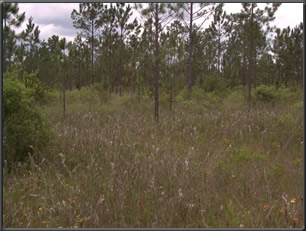Mineral Flats
 Mineral soil flats are most common
on interfluves, extensive relic lake bottoms, or large floodplain terraces where
the main source of water is precipitation. They receive virtually no groundwater
discharge, which distinguishes them from depressions and slopes. Dominant hydrodynamics
are vertical fluctuations. Mineral soil flats lose water by evapotranspiration,
overland flow, and seepage to underlying groundwater. They are distinguished from
flat upland areas by their poor vertical drainage due to impermeable layers (e.g.,
hardpans), slow lateral drainage, and low hydraulic gradients. Mineral soil flats
that accumulate peat can eventually become organic soil flats. They typically occur
in relatively humid climates. Pine flatwoods with hydric soils are an example of
mineral soil flat wetlands.
Mineral soil flats are most common
on interfluves, extensive relic lake bottoms, or large floodplain terraces where
the main source of water is precipitation. They receive virtually no groundwater
discharge, which distinguishes them from depressions and slopes. Dominant hydrodynamics
are vertical fluctuations. Mineral soil flats lose water by evapotranspiration,
overland flow, and seepage to underlying groundwater. They are distinguished from
flat upland areas by their poor vertical drainage due to impermeable layers (e.g.,
hardpans), slow lateral drainage, and low hydraulic gradients. Mineral soil flats
that accumulate peat can eventually become organic soil flats. They typically occur
in relatively humid climates. Pine flatwoods with hydric soils are an example of
mineral soil flat wetlands.
Example Subclasses

Back to HGM Approach
Web Date: October 1997
Updated: February 2022
|

